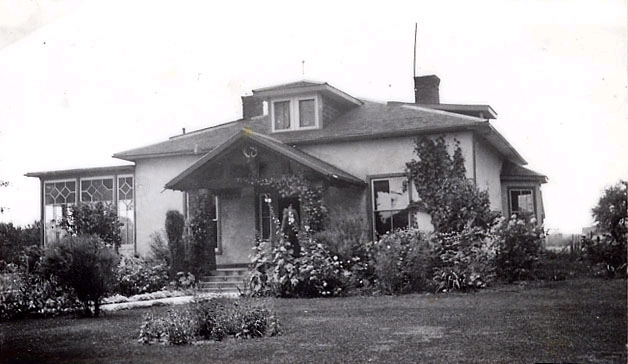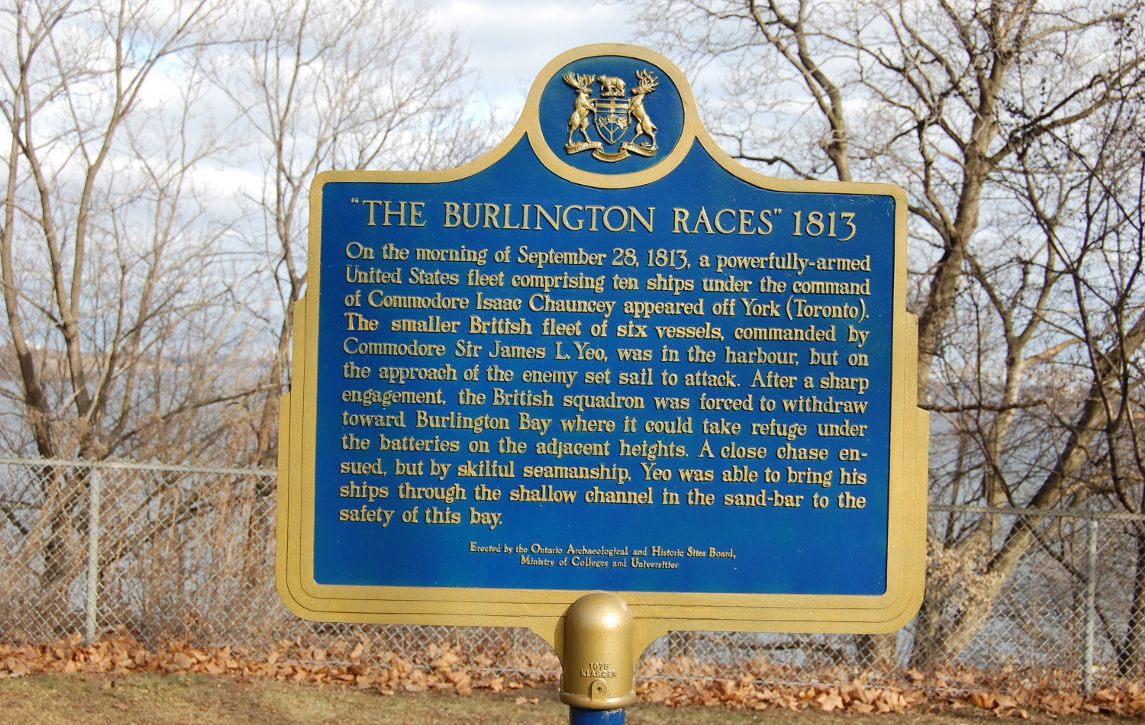The Thompson family were staunch Loyalists, with strong military traditions.
In 1808 Cornelius Thompson, Rebecca’s husband, travelled to York from New Brunswick with Stephen Jarvis, and applied for a land grant in Upper Canada. Cornelius received 480 acres in Toronto Township (historic Mississauga) – Lots 33 and 34 in Concessions 3 & 4, SDS.
In the spring of 1809 the Thompson family made the long trip from New Brunswick to their new land grant. Together with his four sons, Cornelius erected a log cabin on Lot 33, and shortly thereafter, about 1810, commenced building a larger more substantial home which they would dub “Harwood”, on Lot 34.

This area would become known, over time, as Merigold’s Point and Clarkson, now within the City of Mississauga. The Thompson family’s land holdings were just to the west of the lands owned by the Bradley family, home today to the Bradley House and the Museums of Mississauga.
On the eve of the War of 1812, the Thompson family was well connected politically and militarily, owned significant amounts of land, and Cornelius frequently granted mortgages to others – suggesting that the family was relatively well-to-do.
Rebecca (nee Emmons, 1759-1828) and Cornelius Thompson (1756-1814) had seven children: William (1786-1860), Augustus (1788-?), Frederick (1790-?), Amelia (1792-1864), Mary (1793-1880), Cornelius Oliver (1797-1813), and Sarah (1800-1880).
In 1811, Cornelius received an additional land grant in Grantham Township (near St. Catharines), and Cornelius and Rebecca, together with several of their younger children, moved to this new property, leaving the properties in Toronto Township in the care of their eldest sons, William and Augustus.
Of their children, William, Augustus, Frederick and Cornelius Oliver all enlisted with the 2nd Regiment of the York Militia during the War of 1812, and were present at many battles during the war, including Queenston Heights and Lundy’s Lane.
William was a captain with the 2nd York militia, and Heritage Mississauga’s 2nd York re-enactment company, Thompson’s Company, is named in his honour. Also, Thompson Street in Erindale Village is named for William.

William and Augustus were captured by American forces during a raid on St. David’s in 1814, and were imprisoned in the United States for the remainder of the war, being released in February of 1815.
Their brother, Frederick, was wounded at the Battle of Chippawa. The youngest brother, Cornelius Oliver, unfortunately succumbed to illness in June of 1813 – he was only 16 years old when he died.
Their father, Cornelius, died on August 7, 1814, shortly after learning of the capture of his two sons and reportedly still in grief over the loss of his youngest son and namesake: “… his sorrow was more than his weakened state could sustain …”
According to family history records, Cornelius reportedly sent Rebecca and their younger children back to Toronto Township for safety in the early days of the war, as Grantham Country was seen as being too close to the American boarder.
After the war, Rebecca and at least one daughter, Sarah, must have returned to the Grantham/Niagara area as they are buried at St. Mark’s Anglican Cemetery in Niagara-on-the-Lake.
The youngest daughter, Sarah, married Captain Edgeworth Ussher of Chippawa, who himself was murdered in 1838, reportedly by vengeful rebels during the tumult of the Rebellion of 1837. But that is another story.
Back to Rebecca: family correspondence from the 1930s records an interesting tale relating to Rebecca, and her resolve may well be seen in the military tendencies of her sons.
There is some ambiguity around the story itself. For example, the story is recorded as taking place in 1813, but we do not know when it happened exactly. Nor do we know if it took place here in historic Mississauga or in Grantham or Niagara.
The story goes as such: “In 1813 American ships on Lake Ontario strayed close to shore in pursuit of British ships from York. Rebecca, witnessing the passing of several ships in close proximity to the shore, and with her sons away with the militia, took aim with a musket and fired at a passing Yankee ship. She let it be known that the enemy would find no friendly shelter on the shore.”
While the precise date of the incident is unknown, one wonders if it may have been connected to the “Burlington Races” of September 1813.

This is one of the only known instances where ships were known to have strayed close to the shore, although there may well have been others.
In brief, the “Burlington Races” refer to a naval engagement on Lake Ontario that took place on a Tuesday afternoon on September 28, 1813, whose outcome could well have tilted the balance of power in the war.
The American squadron was headed by Commodore Isaac Chauncey aboard his flagship, the sloop-of-war USS General Pike. Opposing him was Royal Navy Commodore Sir James Yeo aboard the Provincial Marine flagship HMS Wolfe.
The American squadron outnumbered the British, 10 ships to 6, and outgunned them as well, 3-2, as well as having heavier and longer-range canons. The British ships were faster, and more maneuverable.
The British squadron, seeing the approach of the American ships, slipped from the harbour at York, and made a break for open water.
The “race” was on.

This pivotal battle for control of Lake Ontario, and perhaps the war itself, took place within eyesight of the shoreline, between modern Port Credit, Bronte and Burlington. Some witnesses watching from shore as the squadrons maneuvered for position likened what they saw to a yacht race – hence the name “Burlington Races”.
For a time, the control of the lake was precarious, as the Wolfe was pounded, losing her topmast and mainsail, while the Pike was holed beneath the water line. As the afternoon progressed, the winds increased, and the British squadron made their run for the head of the lake and taking up a strong defensive position near Burlington.
The American squadron withdrew to Niagara. The outcome was a stalemate of sorts, with control of the lake, and the war, remaining contested. And much of this happened within view of the shore. We will explore the story of the “Burlington Races” in more detail in a future article.
It is fascinating to think, however, that somewhere off of Mississauga, in the deep, cold waters of Lake Ontario, the mainmast of the HMS Wolfe perhaps still lies, and maybe, somewhere nearby, also lies the musket ball fired by Rebecca Thompson.
There is no known picture of Rebecca.
This article can also be found in Modern Mississauga: https://www.modernmississauga.com/main/2021/3/31/remembering-mississaugas-rebecca-thompson-and-the-races



Comments are closed.